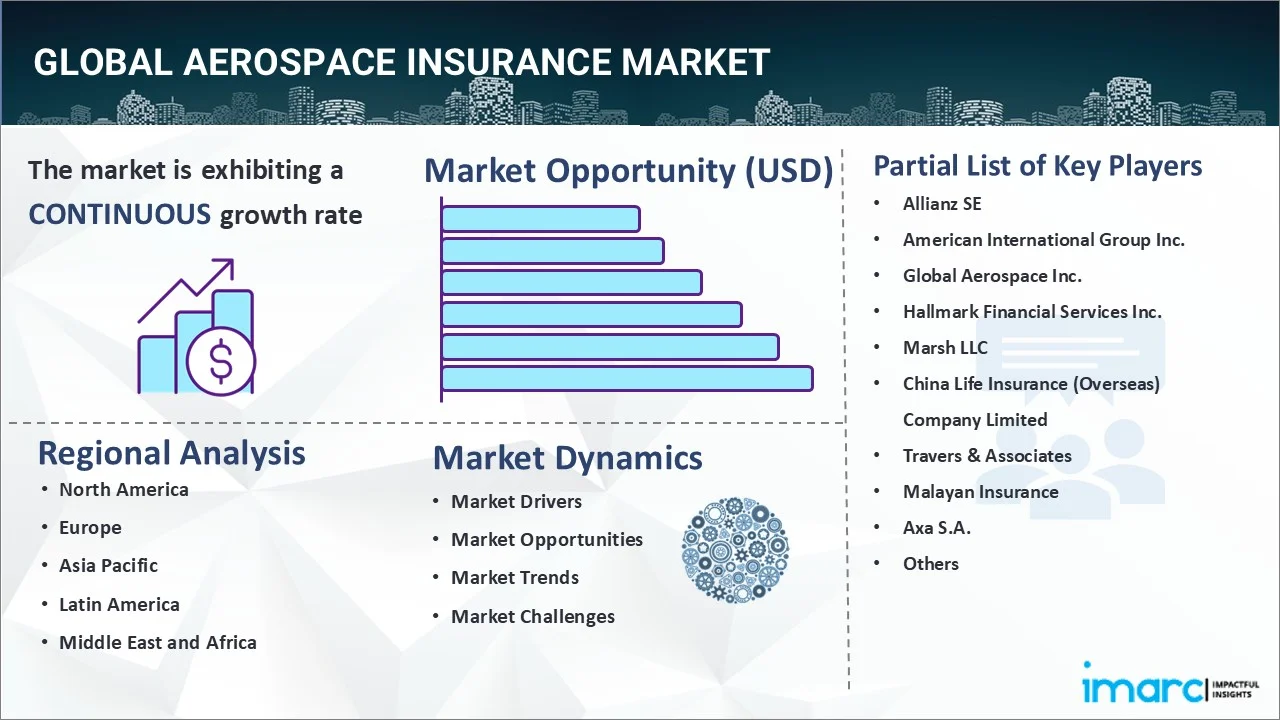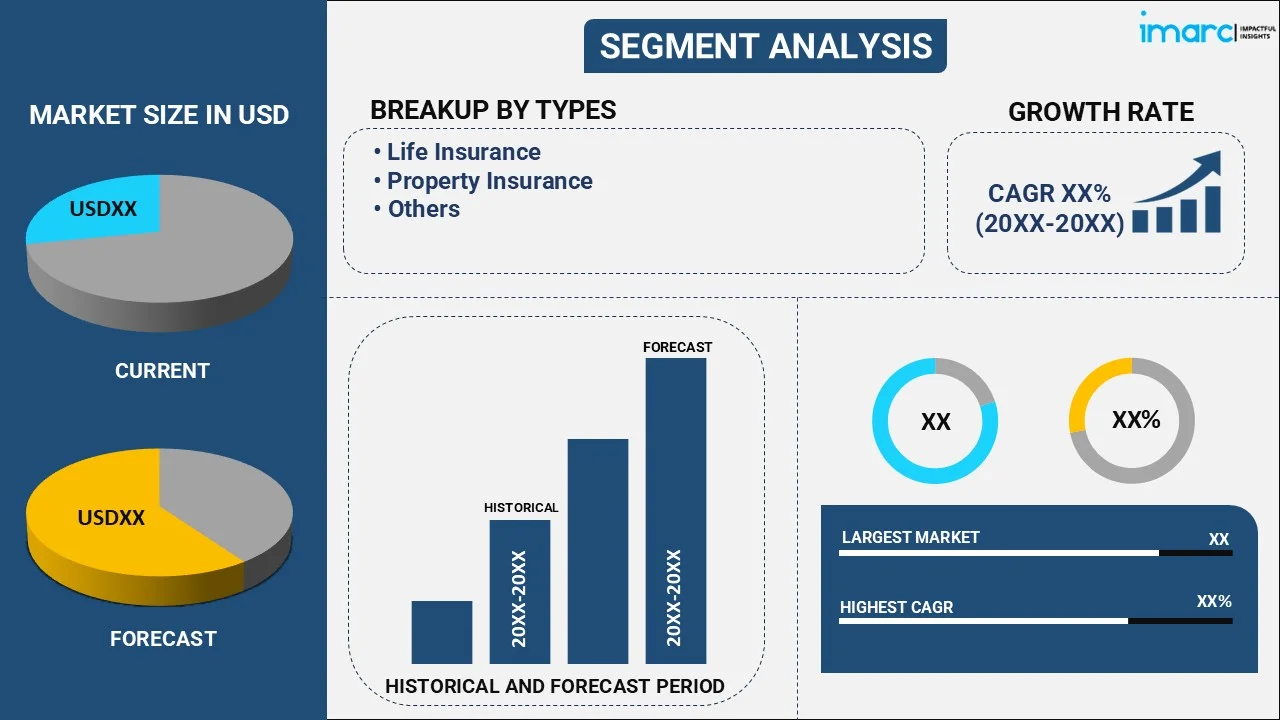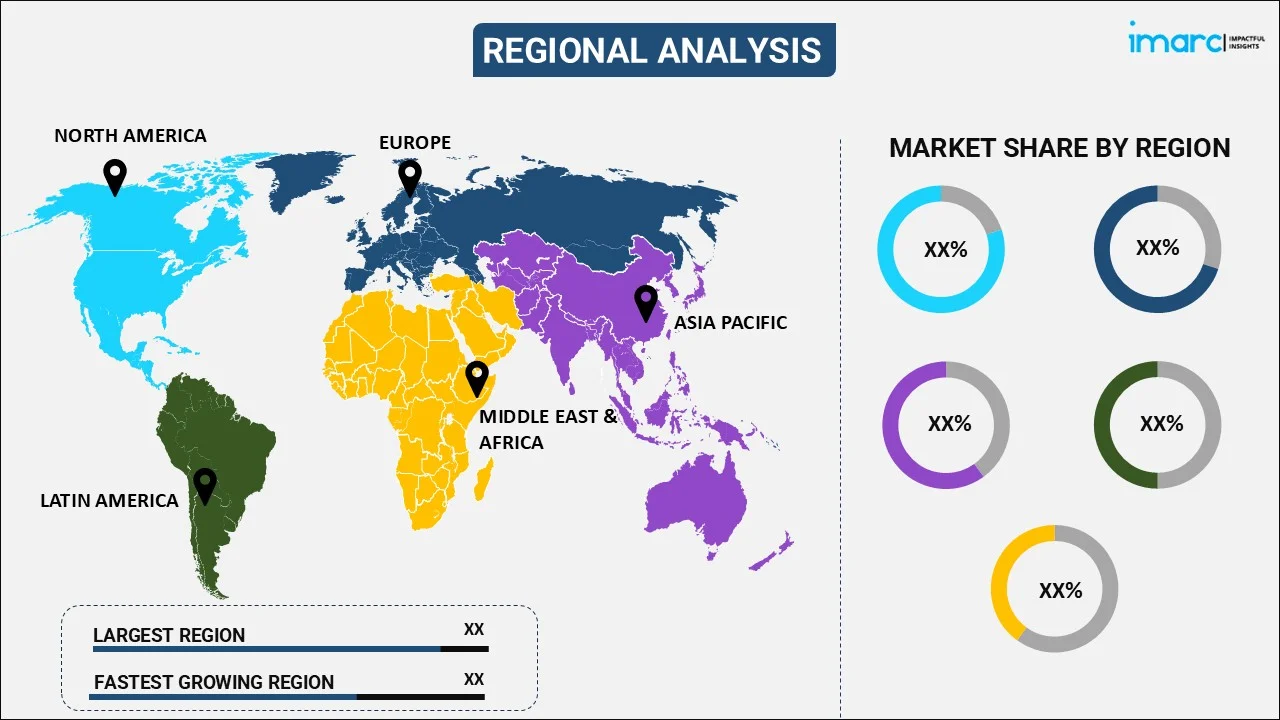
Aerospace Insurance Market Report by Type (Life Insurance, Property Insurance, and Others), Application (Service Providers, Airport Operators, and Others), and Region 2025-2033
Aerospace Insurance Market Size:
The global aerospace insurance market size reached USD 896.5 Million in 2024. Looking forward, IMARC Group expects the market to reach USD 1,157.5 Million by 2033, exhibiting a growth rate (CAGR) of 2.88% during 2025-2033. The market is experiencing steady growth driven by the escalating demand for commercial air travel facilities, increasing integration of artificial intelligence (AI) to improve the functionalities of aircrafts, and rising digital transformation of various insurance procedures.
|
Report Attribute
|
Key Statistics
|
|---|---|
|
Base Year
|
2024
|
|
Forecast Years
|
2025-2033
|
|
Historical Years
|
2019-2024
|
|
Market Size in 2024
|
USD 896.5 Million |
|
Market Forecast in 2033
|
USD 1,157.5 Million |
| Market Growth Rate 2025-2033 | 2.88% |
Aerospace Insurance Market Analysis:
- Market Growth and Size: The aerospace insurance market is experiencing robust growth, on account of the increasing demand for commercial air travel and rising digitalization of aircraft systems and airline operations.
- Major Market Drivers: The primary factors include the evolving regulatory requirements, rising frequency and severity of natural disasters, including hurricanes and wildfires, and increasing focus on renovating aircrafts.
- Technological Advancements: Ongoing innovations are introducing new complexities and risks in the aerospace sector, such as autonomous flight systems and cybersecurity threats. Aerospace insurers are adapting by offering specialized coverage to address these emerging challenges.
- Industry Applications: The aerospace insurance market serves a wide range of industry stakeholders, including airlines, aircraft manufacturers, airport operators, and service providers.
- Key Market Trends: Notable trends include the digital transformation of the insurance process, increased focus on sustainability and environmental, social, and governance (ESG) considerations, and the proliferation of insurtech startups in the aviation insurance ecosystem.
- Geographical Trends: North America leads the global aerospace insurance market due to the rising investments in the aviation industry to improve the infrastructure of aircrafts. However, Asia Pacific is emerging as a fast-growing market on account of the escalating demand for commercial air travel facilities.
- Competitive Landscape: Key players in the market are embracing digitalization, expanding their product portfolios, and exploring partnerships with insurtech firms to stay competitive.
- Challenges and Opportunities: Challenges include the evolving nature of risks in aviation, regulatory complexities, and geopolitical uncertainties. Nonetheless, opportunities for catering to emerging markets, addressing climate-related risks, and innovating in response to changing customer needs are projected to overcome these challenges.

Aerospace Insurance Market Trends:
Increasing demand for commercial air travel
The increasing demand for commercial air travel is propelling the growth of the market. This demand can be attributed to various factors, including economic expansion, globalization, and the growth of the middle-class population. As economies expand, people have more disposable income, and this translates into a higher demand for leisure and business travel. Airlines are expanding their fleets and routes to cater to this growing demand. Moreover, the aerospace industry is witnessing a substantial rise in passenger numbers and the frequency of flights. While this growth is promising, it also introduces a higher level of risk. Aerospace insurance plays a crucial role in mitigating these risks by offering coverage for a wide range of potential issues, including aircraft accidents, liability claims, and damage to property or cargo. Aerospace insurers provide comprehensive policies to airlines, aircraft manufacturers, and other industry stakeholders to ensure that they can operate safely and sustainably. This includes coverage for hull insurance to protect the physical aircraft, liability insurance to cover potential legal claims, and coverage for aviation-related risks, such as hijacking or terrorism.
Technological advancements and new aircraft
Technological advancements in the aerospace industry are supporting the growth of the market. The continuous innovation in aircraft design and technology is introducing new risks and complexities that need to be addressed through insurance coverage. Modern aircraft are equipped with advanced systems, including autonomous flight capabilities, sophisticated avionics, and complex control systems. While these innovations enhance efficiency and safety, they also introduce potential vulnerabilities, such as cybersecurity threats. Aerospace insurers are adapted to provide specialized coverage to protect against these emerging risks, ensuring that airlines and aircraft manufacturers are adequately prepared. Additionally, the development of environment friendly and fuel-efficient aircraft, such as electric or hybrid-electric planes, is another area of technological advancement in the aerospace sector. Insurers are actively involved in evaluating the risks associated with these innovative technologies and tailoring insurance solutions to cover any potential setbacks or liabilities arising from their use.
Regulatory changes and risk management
Regulatory changes and the increasing emphasis on risk management within the aerospace industry are bolstering the market growth. Aviation authorities worldwide are continually updating safety and operational standards to ensure the highest level of passenger safety and environmental responsibility. Airlines and aerospace companies are under greater scrutiny to comply with these evolving regulations. This heightened focus on compliance necessitates more comprehensive insurance coverage. Aerospace insurers offer specialized policies that align with the latest regulatory requirements, ensuring that their clients meet the necessary standards. Additionally, risk management practices are becoming integral to the aerospace sector. Airlines and aircraft manufacturers are proactively assessing and mitigating potential risks associated with their operations. Aerospace insurance is an essential component of this risk management strategy, providing financial protection in case of unforeseen events, such as accidents, natural disasters, or supply chain disruptions.
Cybersecurity threats
As the aerospace industry becomes more digitalized, with aircraft systems and airline operations relying on advanced technology, the vulnerability to cybersecurity threats is rising. The risk of cyberattacks, data breaches, and system vulnerabilities poses a significant challenge to aviation safety and operations. Aerospace insurers are responding to this evolving threat landscape by developing specialized cyber insurance products tailored to the unique needs of the industry. These cyber insurance policies cover potential losses resulting from cyber incidents, including business interruption, data breach response, and liability arising from third-party claims. As the aerospace sector continues to integrate digital technology into its operations, the demand for cybersecurity insurance solutions is a significant driver in the market, ensuring that aviation stakeholders are protected against the potential financial consequences of cyber threats.
Natural disasters and extreme weather events
The increasing frequency and severity of natural disasters, such as hurricanes, wildfires, and severe weather events, pose significant risks to the aerospace industry. These events can damage aircraft, airport facilities, and aviation infrastructure, leading to substantial financial losses. Aerospace insurers provide coverage to protect against such risks, ensuring that aviation stakeholders can recover from the financial impact of natural disasters. Climate change-related challenges, including more frequent and severe weather events, are leading to greater demand for insurance solutions that address environmental and weather-related risks in the aerospace sector. As climate-related risks continue to evolve, aerospace insurers are adapting their offerings to meet the changing needs and challenges of the industry.
Aging aircraft fleets
Airlines often operate older aircraft due to budget constraints or specific operational needs. While these older aircraft can still be safe and reliable, they may require more frequent maintenance and repairs, leading to increased costs. Aerospace insurers offer specialized coverage to address the unique risks associated with aging aircraft, helping airlines manage their operations more effectively.
This coverage can include protection against potential mechanical failures, structural issues, and the increased likelihood of unexpected maintenance requirements. As airlines balance the operational challenges and cost-efficiency of maintaining older fleets, insurance solutions tailored to address these specific risks become essential, making aging aircraft fleets a factor driving the Aerospace Insurance market.
Aerospace Insurance Industry Segmentation:
IMARC Group provides an analysis of the key trends in each segment of the market, along with forecasts at the global and regional levels for 2025-2033. Our report has categorized the market based on type and application.
Breakup by Type:

- Life Insurance
- Property Insurance
- Others
Property insurance accounts for the majority of the market share
The report has provided a detailed breakup and analysis of the market based on the type. This includes life insurance, property insurance, and others. According to the report, property insurance represented the largest segment.
Property insurance primarily encompasses insurance policies that protect individuals, businesses, and organizations against financial losses resulting from damage or loss of physical properties, such as homes, buildings, and valuable assets. Property insurance policies can vary widely, covering events like fire, natural disasters, theft, and vandalism. This segment is crucial for homeowners, property owners, and businesses alike, as it provides a safety net against unforeseen events that could result in significant financial setbacks.
The life insurance segment focuses on providing financial protection to individuals and their families in the event of the death of the policyholder. Life insurance policies come in various forms, including term life, whole life, and universal life insurance. These policies offer beneficiaries a financial payout, often referred to as a death benefit, upon the passing of the policyholder.
Breakup by Application:
- Service Providers
- Airport Operators
- Others
Airport operators hold the largest share in the industry
A detailed breakup and analysis of the market based on the application have also been provided in the report. This includes service providers, airport operators, and others. According to the report, airport operators accounted for the largest market share.
The airport operators segment represents the largest portion of the market in the aviation industry. Airport operators are responsible for the management, operation, and maintenance of airports and their associated facilities. These entities play a critical role in ensuring the efficient functioning of airports, from passenger services to air traffic management. Airport operators require a range of specialized insurance coverage, including liability insurance for accidents, property insurance for airport infrastructure, and business interruption coverage to address potential revenue losses during disruptions.
The service providers segment encompasses a diverse range of companies and organizations that provide services to the aviation industry, excluding airport operations itself. This category includes airlines, ground handling companies, catering services, aircraft maintenance providers, and many others. Each service provider faces unique risks related to their specific operations. Airlines require coverage for passenger liability and aircraft damage, while maintenance companies need insurance for errors and omissions.
Breakup by Region:

- North America
- Europe
- Asia Pacific
- Middle East and Africa
- Latin America
North America leads the market, accounting for the largest aerospace insurance market share
The market research report has also provided a comprehensive analysis of all the major regional markets, which include North America, Europe, Asia Pacific, the Middle East and Africa, and Latin America. According to the report, North America accounted for the largest market share.
The North America aerospace insurance market is driven by the increasing digitalization in the insurance industry. Insurers are adopting advanced technologies, such as artificial intelligence (AI) and data analytics, to enhance underwriting, claims processing, and customer experience. This digital shift is driven by the need for efficiency, personalization, and cost-effectiveness. Regulatory developments, particularly in the United States, are shaping the insurance landscape. Regulatory changes, such as those related to healthcare insurance and cybersecurity requirements, are influencing product offerings and risk management practices.
Asia Pacific maintains a strong presence driven by the expanding middle class with greater purchasing power. This growth is fueling demand for various insurance products, including life, health, and property insurance. Emerging markets in Asia Pacific, such as India and Southeast Asian countries, present significant opportunities for insurance companies. Rising awareness of insurance benefits and the expanding customer base are propelling the market growth in these regions.
Europe stands as another key region in the market, driven by the need for greater transparency and risk assessment. Environmental, social, and governance (ESG) considerations are gaining prominence in Europe. Insurers are incorporating ESG criteria into their investment strategies and product offerings to meet evolving customer expectations.
Latin America exhibits growing potential in the aerospace insurance market, fueled by the increasing number of insurers offering innovative, flexible products that cater to changing economic conditions.
The Middle East and Africa region show a developing market for aerospace insurance, driven by the increasing demand for property and construction-related insurance coverage.
Leading Key Players in the Aerospace Insurance Industry:
Key players in the insurance market are strategically adapting to changing customer needs and technological advancements. They are investing heavily in digitalization, using artificial intelligence (AI) and data analytics to improve underwriting precision, claims processing efficiency, and customer engagement. Moreover, these players are expanding their product portfolios to meet emerging risks, such as cybersecurity and climate change. Many insurers are embracing sustainable practices and incorporating environmental, social, and governance (ESG) criteria into their investment strategies and insurance offerings to align with evolving customer expectations and regulatory requirements. Additionally, they are exploring partnerships with insurtech startups to stay innovative and competitive in a rapidly evolving industry landscape.
The market research report has provided a comprehensive analysis of the competitive landscape. Detailed profiles of all major companies have also been provided. Some of the key players in the market include:
- Allianz SE
- American International Group Inc.
- Global Aerospace Inc.
- Hallmark Financial Services Inc.
- Marsh LLC
- China Life Insurance (Overseas) Company Limited
- Travers & Associates
- Malayan Insurance
- Axa S.A.
- ING Group
- Old Republic Aerospace
- Hiscox Ltd.
- Wells Fargo & Company
- Avion Insurance
(Please note that this is only a partial list of the key players, and the complete list is provided in the report.)
Latest News:
- November 2021: Global Aerospace Inc. and SkyWatch collaborated to launch a usage-based insurance product for rented light aircraft that offers yearly, monthly, weekly, and daily coverage options.
- November 2022: Marsh LLC announced that it has placed insurance for the first space rocket launch from UK soil.
Aerospace Insurance Market Report Scope:
| Report Features | Details |
|---|---|
| Base Year of the Analysis | 2024 |
| Historical Period | 2019-2024 |
| Forecast Period | 2025-2033 |
| Units | Million USD |
| Scope of the Report | Exploration of Historical Trends and Market Outlook, Industry Catalysts and Challenges, Segment-Wise Historical and Future Market Assessment:
|
| Types Covered | Life Insurance, Property Insurance, Others |
| Applications Covered | Service Providers, Airport Operators, Others |
| Regions Covered | Asia Pacific, Europe, North America, Latin America, Middle East and Africa |
| Companies Covered | Allianz SE, American International Group Inc., Global Aerospace Inc., Hallmark Financial Services Inc., Marsh LLC, China Life Insurance (Overseas) Company Limited, Travers & Associates , Malayan Insurance, Axa S.A., ING Group, Old Republic Aerospace, Hiscox Ltd., Wells Fargo & Company, Avion Insurance, etc. |
| Customization Scope | 10% Free Customization |
| Post-Sale Analyst Support | 10-12 Weeks |
| Delivery Format | PDF and Excel through Email (We can also provide the editable version of the report in PPT/Word format on special request) |
Key Benefits for Stakeholders:
- IMARC’s industry report offers a comprehensive quantitative analysis of various market segments, historical and current market trends, market forecasts, and dynamics of the aerospace insurance market from 2019-2033.
- The research report provides the latest information on the market drivers, challenges, and opportunities in the global aerospace insurance market.
- The study maps the leading, as well as the fastest-growing, regional markets.
- Porter's five forces analysis assists stakeholders in assessing the impact of new entrants, competitive rivalry, supplier power, buyer power, and the threat of substitution. It helps stakeholders to analyze the level of competition within the aerospace insurance industry and its attractiveness.
- The competitive landscape allows stakeholders to understand their competitive environment and provides insight into the current positions of key players in the market.
Key Questions Answered in This Report
The global aerospace insurance market was valued at USD 896.5 Million in 2024.
We expect the global aerospace insurance market to exhibit a CAGR of 2.88% during 2025-2033.
The sudden outbreak of the COVID-19 pandemic had led to the implementation of stringent lockdown regulations across several nations, resulting in the decline of aviation activities, thereby negatively impacting the global market for aerospace insurance.
The rising development of smart airports, that utilizes various automated solutions, such as self-check-in kiosks and automated baggage handling systems, is primarily driving the global aerospace insurance market.
Based on the type, the global aerospace insurance market has been divided into life insurance, property insurance, and others. Among these, property insurance currently accounts for the majority of the global market share.
Based on the application, the global aerospace insurance market can be bifurcated into service providers, airport operators, and others. Currently, airport operators exhibit a clear dominance in the market.
On a regional level, the market has been classified into North America, Europe, Asia Pacific, Middle East and Africa, and Latin America, where North America currently dominates the global market.
Some of the major players in the global aerospace insurance market include Allianz SE, American International Group Inc., Avion Insurance, Axa S.A., China Life Insurance (Overseas) Company Limited, Global Aerospace Inc., Hallmark Financial Services Inc., Hiscox Ltd., ING Group, Malayan Insurance, Marsh LLC, Old Republic Aerospace, Travers & Associates, Wells Fargo & Company, etc.
Need more help?
- Speak to our experienced analysts for insights on the current market scenarios.
- Include additional segments and countries to customize the report as per your requirement.
- Gain an unparalleled competitive advantage in your domain by understanding how to utilize the report and positively impacting your operations and revenue.
- For further assistance, please connect with our analysts.
 Inquire Before Buying
Inquire Before Buying
 Speak to an Analyst
Speak to an Analyst
 Request Brochure
Request Brochure
 Request Customization
Request Customization




.webp)




.webp)












